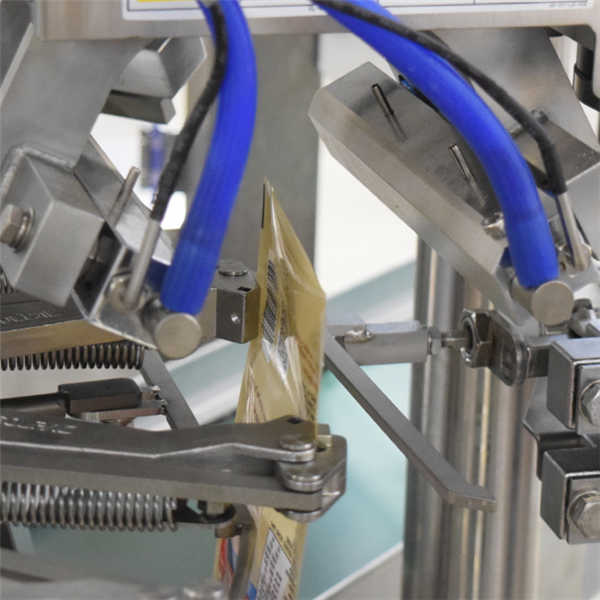Author:Mark Motty Date:December 09, 2018
Automatic pouch filling and sealing machines are becoming increasingly popular today for their simplicity, ease-of-use, and the superior aesthetics of their finished product.
Whether you are new to packaging automation or are considering adding premade pouch packaging to your product lineup, you are probably interested in how these machines operate.
Today we are taking a step-by-step look at the processes involved in turning an empty premade pouch into a shelf-ready finished product.
Bag filling and sealing machines can be designed with an inline or rotary layout. For the purpose of today's article, we are diving deeper into the rotary layout. This design conserves plant floor space and is constructed with ergonomics top-of-mind, and thus is seeing more popularity than inline models.
Simplified, ROTARY AUTOMATIC POUCH PACKING MACHINES grip a preformed pouch, fill it with product, and seal it, at speeds of up to 200 bags per minute. This process involves moving the bag in an intermittent rotary fashion to different 'stations' positioned in a circular layout. Each station performs a different packaging task. There are usually between 6 and 10 stations, with 8 being the most popular configuration. Automatic pouch filling machines can also be designed with a SINGLE LANE, TWO LANES, or FOUR LANES. Here is how the pouch packaging process works:

PREFORMED POUCHES are loaded manually by an operator into the bag magazine in the front of the automatic pouch filling/sealing machine. The bags are conveyed to the machine by a bag feeding roller.
In 2018, Gearpackaging developed a proprietary robotic bag infeed that completely eliminates much of the labor involved in properly loading and shingling premade pouches in the bag magazine. This robotic arm uses vacuum suction to grasp individual bags and load them into the bag gripping area. CONTACT US to see this technology in action.

When a bag is detected by a proximity sensor, a vacuum bag loader picks up the pouch and transfers it to a set of grippers, which will hold the bag as it travels around the rotary unit to different 'stations'.
These grippers can continually support up to 10 kg on the best bag filling and sealing machine models.
If printing or embossing is desired, that equipment will be placed at this station. POUCH FILL AND SEAL MACHINES can utilize both thermal and inkjet printers. The printer can place desired date/lot codes on the pouches. The embossing option places raised date/lot codes into the bag seal.

If the bag has a zipper reclosure, a vacuum suction pad opens the lower part of the preformed pouch and opening jaws catch the top side of the bag. The opening jaws separate outward to open the top of the bag and the premade pouch is inflated by an air blower. If the bag does not have a zipper, the vacuum suction pads still open the bottom part of the pouch but only the air blower is engaged.
Two sensors are present at the bottom of the bag to detect its presence. If a bag is not detected, the filling and sealing stations will not engage. If a bag is present but not placed correctly, it will not be filled and sealed and instead stay on the rotary apparatus until the next cycle.

Product is dropped down a bag funnel into the bag, usually by a multi-head scale. For POWDER PRODUCTS, an auger filler is used. In the case of LIQUID POUCH FILLING MACHINES, product is pumped into the bag by a liquid filler with a nozzle. The filling apparatus is responsible for the correct measurement and release of discrete quantities of product to be dropped into each premade pouch.
Options at the filling station include:
Sometimes loose contents need to settle to the bottom of the bag before sealing. This station gently shakes the premade pouch to achieve that.
Other options at this station include:

Remaining air is squeezed out of the bag by two deflator components before sealing occurs.
A hot seal bar closes on the upper part of the pouch. Using heat and pressure, the sealant layers of the premade pouch are bonded together to make a strong seam.
A cooling bar passes over the seal to strengthen and flatten it. The finished bag is then discharged into a receptacle or onto a conveyor and can be transported to downline equipment like check weighers, x-ray machines, CASE PACKING, OR CARTON PACKING EQUIPMENT.
Contact: Tony
Phone: +86-188-1682-5234
Tel: +86-188-1682-5234
Company: Shenzhen Gerong Industrial Corporation Limited
Add: Shangxue Technology Industrial Park,Jihua Road, Bantian, Longgang District, Shenzhen,Guangdong,China